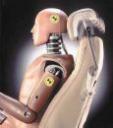 Even the lowly automotive crash test dummy had to be adapted to consider the rising number of obese people from all over the world. These human-like substitutes took the place of real people when the tests began to involve lethal forces that would have surely cut short the life of any volunteer (they actually used real people to test the effectivity of seatbelts when they were invented in real crashes). The newest versions of these unsung heroes of the automotive industry have thousands of sensors embedded within them to monitor all aspects of a crash to see whether an impact is survivable or not. Even with current high-power computers, actual crash tests are still conducted for they offer aspects of a crash that cannot all be factored by computers which rely on input. Real crash shows the way an actual human-like body would bounce around giving designers better insight on how to design their cars better.
Even the lowly automotive crash test dummy had to be adapted to consider the rising number of obese people from all over the world. These human-like substitutes took the place of real people when the tests began to involve lethal forces that would have surely cut short the life of any volunteer (they actually used real people to test the effectivity of seatbelts when they were invented in real crashes). The newest versions of these unsung heroes of the automotive industry have thousands of sensors embedded within them to monitor all aspects of a crash to see whether an impact is survivable or not. Even with current high-power computers, actual crash tests are still conducted for they offer aspects of a crash that cannot all be factored by computers which rely on input. Real crash shows the way an actual human-like body would bounce around giving designers better insight on how to design their cars better.
The results of these crash tests have saved millions of lives with better designs and innovations such as crumple zones that absorb the impact of the crash from reaching the passengers of the vehicles. The reinforcement of the safety cage is also another design result from test crashes wherein a vehicle is constructed in a way to maximize the survival of it’s passengers by maintaining a survivable space in the cab where they are located.
Recent accidents that have involved obese people which are not factored into crash tests due to their falling out of the normal range in terms of body mass and structure resulting in fatal crashes. Auto manufacturers have been forced to reconsider their needs and thus have added a couple of obese dummies in their quest o satisfy all their customers. Obesity is a rising problem in the US and elsewhere with many getting well out of the standard data sets of body size, height and weight proportions crash test dummies were usually designed to, factoring them in allows manufacturers and designers to make their vehicles safe for all people from all walks of life.